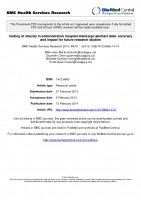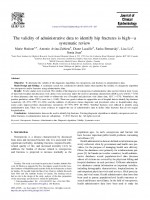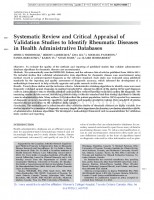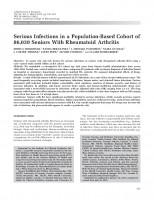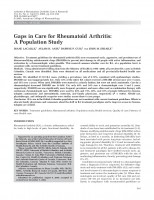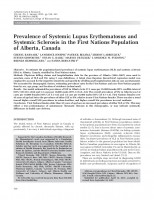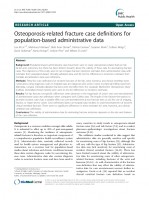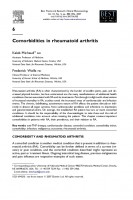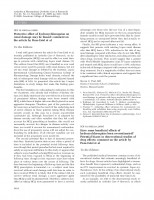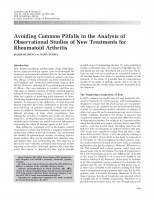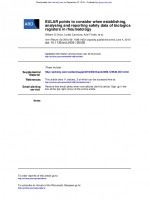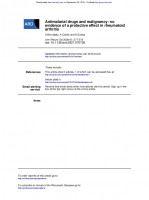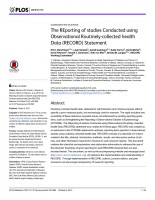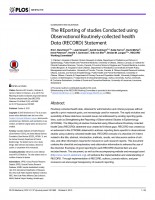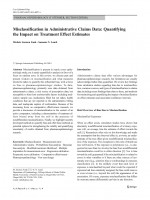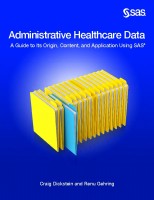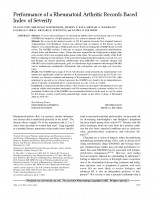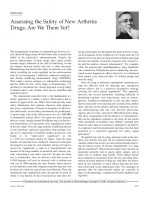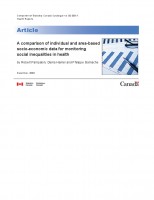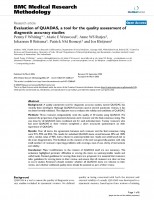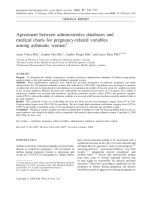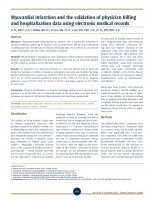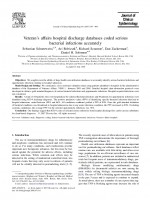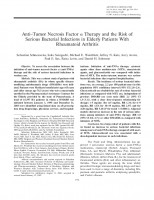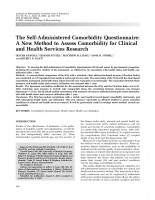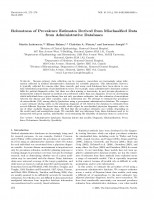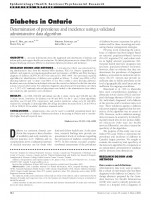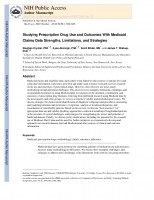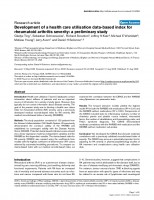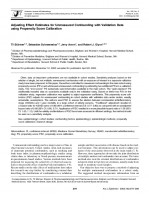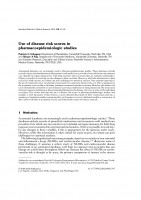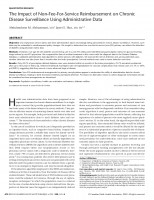This section contains information such as Meds with DIN numbers, ICD9 Medical Codes, Case Definitions, Research Methodology Issues etc.
Sort research methodology by origin:
Abstract
Background: Obesity is a pervasive problem and a popular subject of academic assessment. The ability to take advantage of existing data, such as administrative databases, to study obesity is appealing. The objective of our study was to assess the validity of obesity coding in an administrative database and compare the association between obesity and outcomes in an administrative database versus registry.
Methods: This study was conducted using a coronary catheterization registry and an administrative database (Discharge Abstract Database (DAD)). A Body Mass Index (BMI) ≥30 kg/m2 within the registry defined obesity. In the DAD obesity was defined by diagnosis codes E65 –E68 (ICD-10). The sensitivity, specificity, negative predictive value (NPV) and positive predictive value (PPV) of an obesity diagnosis in the DAD was determined using obesity diagnosis in the registry as the referent. The association between obesity and outcomes was assessed.
Results: The study population of 17380 subjects was largely male (68.8%) with a mean BMI of 27.0kg/m2. Obesity prevalence was lower in the DAD than registry (2.4% vs. 20.3%). A diagnosis of obesity in the DAD had a sensitivity 7.75%, specificity 98.98%, NPV 80.84% and PPV 65.94%. Obesity was associated with decreased risk of death or re-hospitalization, though non-significantly within the DAD. Obesity was significantly associated with an increased risk of cardiac procedure in both databases.
Conclusions: Overall, obesity was poorly coded in the DAD. However, when coded, it was coded accurately. Administrative databases are not an optimal datasource for obesity prevalence and incidence surveillance but could be used to define obese cohorts for follow-up.
| Author: | Billie-Jean Martin, Guanmin Chen, Michelle Graham, Hude Quan |
| Requirements: | PDF Reader |
| Category: | Research Papers |
| Date: | February 21, 2014 |
Objective: To determine the validity of the diagnostic algorithms for osteoporosis and fractures in administrative data.
Study Design and Setting: A systematic search was conducted to identify studies that reported the validity of a diagnostic algorithm for osteoporosis and/or fractures using administrative data.
Results: Twelve studies were reviewed.The validity of the diagnosis of osteoporosis in administrative data was fair when at least 3years of data from hospital and physician visit claims were used (area under the receiver operating characteristic [ROC] curve [AUC] 5 0.70) or when pharmacy data were used (with or without the use of hospital and physician visit claims data, AUC O 0.70). Nonetheless, the positive predictive values (PPVs) were low (!0.60). There was good evidence to support the use of hospital data to identify hip fractures (sensitivity: 69e97%; PPV: 63e96%) and the addition of physician claims diagnostic and procedural codes to hospitalization diagnostic codes improved these characteristics (sensitivity: 83e97%; PPV: 86e98%). Vertebral fractures were difficult to identify using administrative data. There was some evidence to support the use of administrative data to define other fractures that do not require hospitalization.
Conclusions: Administrative data can be used to identify hip fractures. Existing diagnostic algorithms to identify osteoporosis and vertebral fractures in administrative data are suboptimal.
| Author: | Hudson M, Avina-Zubieta A, Lacaille D, Bernatsky S, Lix L, Jean S. |
| Category: | Research Methodology |
| Date: | August 31, 2013 |
Download
Objective. To evaluate the quality of the methods and reporting of published studies that validate administrative database algorithms for rheumatic disease case ascertainment.
Methods. We systematically searched MEDLINE, Embase, and the reference lists of articles published from 1980 to 2011. We included studies that validated administrative data algorithms for rheumatic disease case ascertainment using medical record or patient-reported diagnoses as the reference standard. Each study was evaluated using published standards for the reporting and quality assessment of diagnostic accuracy, which informed the development of a methodologic framework to help critically appraise and guide research in this area.
Results. Twenty-three studies met the inclusion criteria. Administrative database algorithms to identify cases were most frequently validated against diagnoses in medical records (83%). Almost two-thirds of the studies (61%) used diagnosis codes in administrative data to identify potential cases and then reviewed medical records to confirm the diagnoses. The remaining studies did the reverse, identifying patients using a reference standard and then testing algorithms to identify cases in administrative data. Many authors (61%) described the patient population, but few (26%) reported key measures of diagnostic accuracy (sensitivity, specificity, and positive and negative predictive values). Only one-third of studies reported disease prevalence in the validation study sample.
Conclusion. The methods used in administrative data validation studies of rheumatic diseases are highly variable. Few studies reported key measures of diagnostic accuracy despite their importance for drawing conclusions about the validity of administrative database algorithms. We developed a methodologic framework and recommendations for validation study conduct and reporting.
| Category: | Research Methodology |
| Date: | August 31, 2013 |
Download
Objective. To assess risk and risk factors for serious infections in seniors with rheumatoid arthritis (RA) using a case–control study nested within an RA cohort.
Methods. We assembled a retrospective RA cohort age >66 years from Ontario health administrative data across 1992–2010. Nested case– control analyses were done, comparing RA patients with a primary diagnosis of infection (based on hospital or emergency department records) to matched RA controls. We assessed independent effects of drugs, adjusting for demographics, comorbidity, and markers of RA severity.
Results. A total of 86,039 seniors with RA experienced 20,575 infections, for a rate of 46.4 events/1,000 person-years. The most frequently occurring events included respiratory infections, herpes zoster, and skin/soft tissue infections. Factors associated with infection included higher comorbidity, rural residence, markers of disease severity, and history of previous infection. In addition, anti–tumor necrosis factor agents and disease-modifying antirheumatic drugs were associated with a several-fold increase in infections, with an adjusted odds ratio (OR) ranging from 1.2–3.5. The drug category with the greatest effect estimate was glucocorticoids, which exhibited a clear dose response with an OR ranging from 4.0 at low doses to 7.6 at high doses.
Conclusion. Seniors with RA have significant morbidity related to serious infections, which exceeds previous reports among younger RA populations. Rural residence, higher comorbidity, markers of disease severity, and previous infection were associated with serious infections in seniors with RA. Our results emphasize that many RA drugs may increase the risk of infection, but glucocorticoids appear to confer a particular risk.
| Category: | Research Methodology |
| Date: | August 31, 2013 |
| Category: | Research Methodology |
| Date: | August 31, 2013 |
Download
Objective. To estimate the population-based prevalence of systemic lupus erythematosus (SLE) and systemic sclerosis (SSc) in Alberta, Canada, stratified by First Nations status.
Methods. Physician billing claims and hospitalization data for the province of Alberta (1994–2007) were used to ascertain cases of SLE and SSc using 3 case definitions. A latent class Bayesian hierarchical regression model was employed to account for the imperfect sensitivity and specificity of billing and hospitalization data in case ascertainment. We accounted for demographic factors, estimating prevalence rates for the First Nations and non–First Nations popula- tions by sex, age group, and location of residence (urban/rural).
Results. Our model estimated the prevalence of SLE in Alberta to be 27.3 cases per 10,000 females (95% credible interval [95% CrI] 25.9 –28.8) and 3.2 cases per 10,000 males (95% CrI 2.6 –3.8). The overall prevalence of SSc in Alberta was 5.8 cases per 10,000 females (95% CrI 5.1–6.5) and 1.0 case per 10,000 males (95% CrI 0.7–1.4). First Nations females over 45 years of age had twice the prevalence of either SLE or SSc relative to non–First Nations females. There was also a trend toward higher overall SLE prevalence in urban dwellers, and higher overall SSc prevalence in rural residents.
Conclusion. First Nations females older than 45 years of age have an increased prevalence of either SLE or SSc. This may reflect a true predominance of autoimmune rheumatic diseases in this demographic, or may indicate systematic differences in health care delivery.
| Category: | Research Methodology |
| Date: | August 31, 2013 |
The Manitoba Centre for Health Policy (MCHP) is located within the Department of Community Health Sciences, Faculty of Medicine, University of Manitoba. The mission of MCHP is to provide accurate and timely information to health care decision-makers, analysts and providers, so they can offer services which are effective and efficient in maintaining and improving the health of Manitobans. Our researchers rely upon the unique Population Health Research Data Repository to describe and explain pat- terns of care and profiles of illness, and to explore other factors that influence health, including income, education, employment and social status. This Repository is unique in terms of its comprehensiveness, degree of integration, and orientation around an anonymized population registry.
Members of MCHP consult extensively with government officials, health care administrators, and clinicians to develop a research agenda that is topi- cal and relevant. This strength along with its rigorous academic standards enable MCHP to contribute to the health policy process. MCHP under- takes several major research projects, such as this one, every year under con- tract to Manitoba Health. In addition, our researchers secure external fund- ing by competing for other research grants. We are widely published and internationally recognized. Further, our researchers collaborate with a number of highly respected scientists from Canada, the U.S. and Europe.
We thank the University of Manitoba, Faculty of Medicine, Health Research Ethics Board for their review of this project. The Manitoba Centre for Health Policy complies with all legislative acts and regulations governing the protection and use of sensitive information. We implement strict policies and procedures to protect the privacy and security of anonymized data used to produce this report and we keep the provincial Health Information Privacy Committee informed of all work undertaken for Manitoba Health.
| Category: | Research Methodology |
| Date: | August 31, 2013 |
Abstract
Background: Population-based administrative data have been used to study osteoporosis-related fracture risk factors and outcomes, but there has been limited research about the validity of these data for ascertaining fracture cases. The objectives of this study were to: (a) compare fracture incidence estimates from administrative data with estimates from population-based clinically-validated data, and (b) test for differences in incidence estimates from multiple administrative data case definitions.
Methods: Thirty-five case definitions for incident fractures of the hip, wrist, humerus, and clinical vertebrae were constructed using diagnosis codes in hospital data and diagnosis and service codes in physician billing data from Manitoba, Canada. Clinically-validated fractures were identified from the Canadian Multicentre Osteoporosis Study (CaMos). Generalized linear models were used to test for differences in incidence estimates.
Results: For hip fracture, sex-specific differences were observed in the magnitude of under- and over-ascertainment of administrative data case definitions when compared with CaMos data. The length of the fracture-free period to ascertain incident cases had a variable effect on over-ascertainment across fracture sites, as did the use of imaging, fixation, or repair service codes. Case definitions based on hospital data resulted in under-ascertainment of incident clinical vertebral fractures. There were no significant differences in trend estimates for wrist, humerus, and clinical vertebral case definitions.
Conclusions: The validity of administrative data for estimating fracture incidence depends on the site and features of the case definition.
| Category: | Research Methodology |
| Date: | August 31, 2013 |
Rheumatoid arthritis (RA) is often characterized by the burden of swollen joints, pain, and de- creased physical function, but less understood are the many manifestations of additional health conditions that are associated with RA and its treatments. First brought to light with observations of increased mortality in RA, studies noted the increased rates of cardiovascular and infection events. The chronic, debilitating, autoimmune nature of RA affects the patient directly or indi rectly in almost all organ systems, from cardiovascular problems and infections to depression and gastrointestinal ulcers. On average, the established RA patient has two or more comorbid conditions. It should be the responsibility of the rheumatologist to take these and the risk of additional conditions into account when treating the patient. This chapter reviews important comorbidities in patients with RA, their prevalence, and their relation to RA.
Key words: anti-TNF therapy; cardiovascular disease; comorbid condition; comorbidity index; comorbidity; infection; malignancy; outcomes; rheumatoid arthritis.
| Category: | Research Methodology |
| Date: | August 31, 2013 |
Download
To the Editors:
I read with great interest the article by Pons-Estel et al, recently published in Arthritis Care & Research, on hy- droxychloroquine (HCQ) use and its effect on renal dam- age in persons with underlying lupus renal disease (1). The authors found that HCQ use (classified as ever used versus never used) by persons with renal disease, but not yet any renal damage as defined by the Systemic Lupus International Collaborating Clinics/American College of Rheumatology Damage Index renal domain, reduced the risk of subsequent renal damage with an adjusted hazard ratio (HR) of 0.29. As presented, this article has 2 major limitations in study design that make this finding ques- tionable.
| Category: | Research Methodology |
| Date: | August 31, 2013 |
Download
Introduction
New disease-modifying antirheumatic drugs (DMARDs), and in particular biologic agents, have revolutionized the treatment of rheumatoid arthritis (RA) in the last decade and led to significant improvements in patient outcomes. The efficacy of these treatments has been established in well-designed and -conducted randomized clinical trials (RCTs). However, although RCTs produce good evidence of efficacy, they are expensive to conduct, and thus pro- vide data on limited numbers of highly selected patients followed for short durations of time. Therefore, RCTs are often not capable of providing good estimates of harm, which may require long-term followup of large numbers of patients. In response to this deficiency, several drug and disease registries have been established to provide long- term followup on patients exposed to these new treat- ments. In addition, administrative databases have the ad- ditional advantage of large study populations, thus offering the potential to identify rare events (1). Observa- tional (i.e., nonexperimental) studies of registry data and administrative databases are useful sources of information concerning the safety of biologic agents in RA (2,3).
| Category: | Research Methodology |
| Date: | August 31, 2013 |
Download
ABSTRACT
Objectives: The introduction of biological therapies for the treatment of rheumatic diseases has drawn attention to the limitations of traditional means of assessing drug safety. Consequently, a series of European academic biologics registers dedicated to this task have been established. Increasing reliance upon safety data generated from observational drug registers makes it important to convert the lessons learned from such registers into recommendations for rheumatologists embarking upon the establishment of future registers, or analysing and reporting from new and existing registers.
Methods: The Task Force encompassed 11 scientists from European Rheumatology drug registers. Through
an informal inventory of critical elements in the establishment of existing rheumatoid arthritis drug registers, of analytical strategies used and of limitations of their results, several ‘points to consider’—beyond established generic guidelines for observational registers/ studies but with particular relevance to biologics registers on safety in rheumatology—were assembled. For each ‘point to consider’, contextual and methodological background and examples were compiled.
Results: A set of seven points to consider was assembled for the establishment of new drug registers with a focus on purpose, population to be targeted, data collection, handling and storage as well as ethical and legal considerations. For analysis and reporting, nine points to consider were assembled (setting, participant, variable, statistical method, descriptive data, outcome data, main results, other analyses and limitations).
Conclusions: Thoughtful design and planning before
the establishment of biologics registers will increase
their sustainability, versatility and raw data quality. Harmonisation of analyses and reporting from such registers will improve interpretation of drug safety studies.
| Category: | Research Methodology |
| Date: | August 31, 2013 |
ABSTRACT
Objective: To estimate the effects of biological drugs on the risk of demyelinating events in rheumatoid arthritis (RA).
Methods: Case–control analyses nested in an administrative database cohort.
Results: Initially the risk of demyelinating events appeared to be increased after exposure to anakinra and decreased after exposure to antitumour necrosis factor (anti-TNF) agents. However, this apparent differential risk was due to more anakinra use (and avoidance of anti-TNF agents) in persons at high risk for demyelinating events. In individuals not at high risk, the adjusted rate ratio was 1.31 (95% CI 0.68 to 2.50) after exposure to anti-TNF agents and 0.80 (95% CI 0.29 to 2.24) after exposure to anakinra.
Conclusions: When accounting for differential prescription patterns, there was a trend towards more events after exposure to anti-TNF agents. When studying rare but important potential drug associations, pharmacoepidemiological studies are valuable but must be carefully performed
| Category: | Research Methodology |
| Date: | August 31, 2013 |
Download
Antimalarial agents, particularly hydroxychloroquine, are fre- quently used drugs in rheumatology, particularly in rheumatoid arthritis (RA) and systemic lupus erythematosus (SLE). A growing awareness of increased malignancies in these auto- immune rheumatic conditions has raised suspicions that drugs may alter cancer risk in such patients. In vitro, antimalarial agents have been invoked as potentially increasing1 or decreas- ing2 neoplastic processes in breast cancer cells. It has also been suggested that these drugs may decrease the in vitro activity of lymphocytic leukaemia cells.3 However, there exists no defini- tive literature to show any explicit effect of antimalarial agents on cancer risk in clinical populations.
| Category: | Research Methodology |
| Date: | August 31, 2013 |
Download
Abstract
Routinely collected health data, obtained for administrative and clinical purposes without specific a priori research goals, are increasingly used for research. The rapid evolution and availability of these data have revealed issues not addressed by existing reporting guidelines, such as Strengthening the Reporting of Observational Studies in Epidemiology (STROBE). The REporting of studies Conducted using Observational Routinely collected health Data (RECORD) statement was created to fill these gaps. RECORD was created as an extension to the STROBE statement to address reporting items specific to observational studies using routinely collected health data. RECORD consists of a checklist of 13 items related to the title, abstract, introduction, methods, results, and discussion section of articles, and other information required for inclusion in such research reports. This document contains the checklist and explanatory and elaboration information to enhance the use of the checklist. Examples of good reporting for each RECORD checklist item are also included herein. This document, as well as the accompanying website and message board (http://www.record-statement.org), will enhance the implementation and understanding of RECORD. Through implementation of RECORD, authors, journals editors, and peer reviewers can encourage transparency of research reporting.
| Author: | Eric I. Benchimol, Liam Smeeth, Astrid Guttmann, Katie Harron, David Moher, Irene Petersen, Henrik T. Sørensen, Erik von Elm, Sinéad M. Langan, RECORD Working Committee |
| Category: | Consensus Statements and Best Practices |
| Date: | November 30, 2015 |
Download
Routinely collected health data, obtained for administrative and clinical purposes without specific a priori research goals, are increasingly used for research. The rapid evolution and availability of these data have revealed issues not addressed by existing reporting guidelines, such as Strengthening the Reporting of Observational Studies in Epidemiology (STROBE). The REporting of studies Conducted using Observational Routinely collected health Data (RECORD) statement was created to fill these gaps. RECORD was created as an extension to the STROBE statement to address reporting items specific to observational studies using routinely collected health data. RECORD consists of a checklist of 13 items related to the title, abstract, introduction, methods, results, and discussion section of articles, and other information required for inclusion in such research reports. This document contains the checklist and explanatory and elaboration information to enhance the use of the checklist. Examples of good reporting for each RECORD checklist item are also included herein. This document, as well as the accompanying website and message board (http://www.record-statement.org), will enhance the implementation and understanding of RECORD. Through implementation of RECORD, authors, journals editors, and peer reviewers can encourage transparency of research reporting.
| Author: | Eric I. Benchimol, Liam Smeeth, Astrid Guttmann, Katie Harron, David Moher, Irene Petersen, Henrik T. Sørensen, Erik von Elm, Sinéad M. Langan, RECORD Working Committee |
| Category: | Research Papers |
| Date: | November 2, 2015 |
Download
Abstract: Misclassification is present in nearly every epidemiologic study, yet is rarely quantified in analysis in favor of a focus on random error. In this review, we discuss past and present wisdom on misclassification and what measures should be taken to quantify this influential bias, with a focus on bias in pharmacoepidemiologic studies. To date, pharmacoepidemiology primarily uses data obtained from administrative claims, a rich source of prescription data, but susceptible to bias from unobservable factors including medication sample use, medications filled but not taken, health conditions that are not reported in the administrative billing data, and inadequate capture of confounders. Because of the increasing focus on comparative effectiveness research, we provide a discussion of misclassification in the context of an active comparator, including a demonstration of treatment effects biased away from the null in the presence of nondifferential misclassification. Finally, we highlight recently developed methods to quantify bias and offer these methods as potential options for strengthening the validity and quantifying uncertainty of results obtained from pharmacoepidemiologic research.
| Author: | Michele Jonsson Funk, Suzanne N Landi |
| Category: | Research Papers |
| Date: | September 16, 2015 |
This book provides a concise yet complete foundational knowledge of the business of healthcare.
Administrative Healthcare Data: A Guide to Its Origin, Content, and Application Using SAS explains the source and content of administrative healthcare data, which is the product of ...
Excerpt of book can be downloaded or to view it online click here.
Dickstein, Craig, and Renu Gehring. Administrative Healthcare Data: A Guide to Its Origin, Content, and Application Using SAS. SAS Institute, 2014.
| Author: | Craig Dickstein and Renu Gehring |
| Requirements: | PDF Reader |
| Category: | Research Methodology |
| Date: | November 12, 2014 |
ABSTRACT
Objective. To assess the performance of a rheumatoid arthritis (RA) records-based index of severity (RARBIS) developed by a Delphi panel process in a cohort of patients with RA.
Methods. We reviewed the medical records of 120 RA patients from the New England Veteran’s Administration (VA) Healthcare System and collected data on markers of RA disease severity. Markers were refined through a Delphi panel process before developing the RARBIS based on chart review. The RARBIS includes 5 subscales on surgery, radiography, extraarticular manifestations, clinical status, and laboratory values. Factors that were regarded by the Delphi panel as highly relat- ed to severity of RA were assigned higher points on the index. We assessed the validity of the RAR- BIS by comparing it to the intensity of the actual RA treatment that these patients received: low, nei- ther biologic nor disease modifying antirheumatic drug (DMARD) use; moderate, therapy with DMARD such as hydroxychloroquine, gold, or sulfasalazine; high, treatment with stronger DMARD such as methotrexate, azathioprine, leflunomide, and cyclosporine; and very high, use of any bio- logics.
Results. The RARBIS had a range of 0 to 8. All subscales except extraarticular manifestations were statistically significantly related to intensity of RA treatment (chi-square test p ≤ 0.015); the over- all index was linearly correlated with intensity of RA treatment (r = 0.35, 95% CI 0.18–0.55). After adjusting for age and sex in a linear regression, the RARBIS was found to be an independent pre- dictor of intensity of treatment (ß for 1-point increase in score = 0.16, p = 0.002).
Conclusion. A medical records-based index of RA severity was developed with attention to face and criterion validity that correlated moderately with RA treatment intensity (construct validity) in a VA population. Further tests of the RARBIS are recommended before it can be used as a tool to adjust for RA disease severity in performing epidemiologic studies on the safety of drugs.
| Category: | Research Methodology |
| Date: | August 31, 2013 |
| Category: | Research Methodology |
| Date: | August 31, 2013 |
Download
Abstract
Background: Area-based indicators are commonly used to measure and track health outcomes by socio- economic group. This is largely because of the absence of socio-economic information about individuals in health administrative databases. The literature shows that the magnitude of differences in health outcomes varies depending on whether the socio-economic indicators are at the individual level or are area-based. This study compares the two types of indicators.
Data and methods: The data are from a file linking the results of the 1991 Census with deaths that occurred from
1991 to 2000―a 15% sample of the Canadian population aged 25 or older. The socio-economic indicator used for comparison is a material and social deprivation index, in individual and area- based versions. The health indicators are life expectancy and disability-free life expectancy, and risks of mortality and disability.
Results: The individual version of the deprivation index yields wider gaps in life expectancy and disability- free life expectancy than does the area-based version. These gaps vary by sex and geographic setting. However, both versions are associated with inequalities in mortality and disability, independent of each other.
Interpretation: Despite some limitations, area-based socio- economic indicators are useful in assessing inequalities in health. The inequalities that they identify are significant, consistent and reliable and can be tracked through time and for different geographic settings.
Keywords
area-based measure, deprivation, disability-free life expectancy, geography, life expectancy, social inequalities
| Category: | Research Methodology |
| Date: | August 31, 2013 |
ABSTRACT
Background: A quality assessment tool for diagnostic accuracy studies, named QUADAS, has recently been developed. Although QUADAS has been used in several systematic reviews, it has not been formally validated. The objective was to evaluate the validity and usefulness of QUADAS.
Methods: Three reviewers independently rated the quality of 30 studies using QUADAS. We assessed the proportion of agreements between each reviewer and the final consensus rating. This was done for all QUADAS items combined and for each individual item. Twenty reviewers who had used QUADAS in their reviews completed a short structured questionnaire on their experience of QUADAS.
Results: Over all items, the agreements between each reviewer and the final consensus rating were 91%, 90% and 85%. The results for individual QUADAS items varied between 50% and 100% with a median value of 90%. Items related to uninterpretable test results and withdrawals led to the most disagreements. The feedback on the content of the tool was generally positive with only small numbers of reviewers reporting problems with coverage, ease of use, clarity of instructions and validity.
Conclusion: Major modifications to the content of QUADAS itself are not necessary. The evaluation highlighted particular difficulties in scoring the items on uninterpretable results and withdrawals. Revised guidelines for scoring these items are proposed. It is essential that reviewers tailor guidelines for scoring items to their review, and ensure that all reviewers are clear on how to score studies. Reviewers should consider whether all QUADAS items are relevant to their review, and whether additional quality items should be assessed as part of their review.
| Category: | Research Methodology |
| Date: | August 31, 2013 |
Download
The quality of reporting of studies of diagnostic accuracy is less than optimal. Complete and accurate reporting is necessary to enable readers to assess the potential for bias in the study and to evaluate the generalizability of the results.
A group of scientists and editors has developed the STARD (Standards for Reporting of Diagnostic Accuracy) statement to improve the reporting the quality of reporting of studies of diagnostic accuracy. The statement consists of a checklist of 25 items and flow diagram that authors can use to ensure that all relevant information is present.
This explanatory document aims to facilitate the use, under- standing, and dissemination of the checklist. The document contains a clarification of the meaning, rationale, and optimal use of each item on the checklist, as well as a short summary of the available evidence on bias and applicability.
The STARD statement, checklist, flowchart, and this explanation and elaboration document should be useful resources to improve reporting of diagnostic accuracy studies. Complete and informative reporting can only lead to better decisions in health care.
| Category: | Research Methodology |
| Date: | August 31, 2013 |
Download
SUMMARY
Purpose: To determine the validity of pregnancy variables recorded in administrative databases of Quebec using patient medical charts as the gold standard among asthmatic pregnant women.
Methods: Three administrative databases were linked and provided information on maternal, pregnancy and infant characteristics for 726 pregnant asthmatic women who delivered in 1990–2000. Algorithms were developed to measure variables that were not recorded directly in the databases or to minimize the number of missing values for variables recorded in two or more databases. Medical file data were collected by two trained research nurses in 43 hospitals. The validity of categorical variables was assessed with sensitivity, specificity, predictive positive values (PPVs) and predictive negative values (PNVs), whereas the validity of continuous variables was assessed with Pearson correlation using the medical chart as the gold standard.
Results: The sensitivity of the sex of the baby, previous live birth and previous pregnancy ranged from 0.97 to 0.99. Corresponding figures were 0.92–0.98 for specificity. We also found high correlation coefficients, ranging from 0.875 to 0.999 for the length of gestation, dates of last menstruation and delivery, maternal age and birth weight.
Conclusion: Pregnancy-related variables recorded in administrative databases or derived from algorithms based on two or more databases were found to be highly valid as compared to the medical chart among asthmatic women.
key words — validation; pregnancy-related variables; administrative databases; medical chart; asthma
| Category: | Research Methodology |
| Date: | August 31, 2013 |
Download
Abstract
Objective: Population-based identification of patients with a myocardial infarction is limited to patients presenting to hospital with an acute event. We set out to determine if adding physician billing data to hospital discharge data would result in an accurate capture of patients who have had a myocardial infarction.
Methods: We performed a retrospective chart abstraction of 969 randomly selected adult patients using data abstracted from primary care physicians on an electronic medical record in Ontario, Canada, as the reference standard.
Results: An algorithm of 3 physician billings in a one-year period with at least one being by a specialist or within a hospital or emergency room plus one hospital discharge abstract performed with a sensitivity of 80.4% (95% CI: 69.5-91.3), specificity of 98.0% (95% CI: 97.1-98.9), positive predictive value of 69.5% (95% CI: 57.7-81.2), negative predictive value of 98.9% (95% CI: 98.2% to 99.6%) and kappa statistic of 0.73 (95% CI: 0.63-0.83).
Conclusion: Using a combination of hospital discharge abstracts and physician bill- ing data may be the best way of assessing trends of MI occurrence over time since it increases the capture of MI beyond those patients who have been hospitalized.
| Category: | Research Methodology |
| Date: | August 31, 2013 |
Download
Abstract
Objectives: We sought to test the ability of large health care utilization databases to accurately identify serious bacterial infections and opportunistic infections leading to hospital admission.
Study Design and Setting: We conducted a cross-sectional validation study using patients admitted to hospitals in the administrative database of the Department of Veterans Affairs, VISN 1, between 2001 and 2004. Detailed hospital chart abstraction protocols were developed to define a gold-standard diagnosis of serious bacterial infections and opportunistic infections. Hospital acquired infections were not considered.
Results: A total of 158 patients who were hospitalized for selected bacterial infections and 69 patients for opportunistic infections were identified using ICD-9 discharge diagnoses. The positive predictive values (PPV) of identifying specific bacterial infections that lead to hospital admissions varied between 100% and 66%. All conditions combined yielded a PPV of 80%. Once the gold-standard definition of bacterial conditions was broadened to hospital admissions due to any acute infectious condition, the PPV increased to 90%. Excluding systemic candidiasis, the average PPV for the selected opportunistic infections was 76%.
Conclusion: Our findings suggest that ICD-9 codes of selected serious infections from hospital discharge files can be used as substitutes for chart-based diagnoses.
| Category: | Research Methodology |
| Date: | August 31, 2013 |
Download
Objective. To assess the association between the initiation of anti–tumor necrosis factor (anti-TNF) therapy and the risk of serious bacterial infections in routine care.
Methods. This was a cohort study of patients with rheumatoid arthritis (RA) in whom specific disease- modifying antirheumatic drugs (DMARDs) were initiated. Patients were Medicare beneficiaries ages 65 years and older (mean age 76.5 years) who were concurrently enrolled in the Pharmaceutical Assistance Contract for the Elderly provided by the state of Pennsylvania. A total of 15,597 RA patients in whom a DMARD was initiated between January 1, 1995 and December 31, 2003 were identified using linked data on all prescription drug dispensings, physician services, and hospitalizations. Initiation of anti-TNF therapy, cytotoxic agents other than methotrexate (MTX), noncytotoxic agents, and glucocorticoids was compared with initia- tion of MTX. The main outcome measure was serious bacterial infections that required hospitalization.
| Category: | Research Methodology |
| Date: | August 31, 2013 |
Download
Objective. To develop the Self-Administered Comorbidity Questionnaire (SCQ) and assess its psychometric properties, including the predictive validity of the instrument, as reflected by its association with health status and health care utilization after 1 year.
Methods. A cross-sectional comparison of the SCQ with a standard, chart abstraction-based measure (Charlson Index) was conducted on 170 inpatients from medical and surgical care units. The association of the SCQ with the chart-based comorbidity instrument and health status (short form 36) was evaluated cross sectionally. The association between these measures and health status and resource utilization was assessed after 1 year.
Results. The Spearman correlation coefficient for the association between the SCQ and the Charlson Index was 0.32. After restricting each measure to include only comparable items, the correlation between measures was stronger (Spearman r
| Category: | Research Methodology |
| Date: | August 31, 2013 |
Download
Two distinct subtypes of hip fracture, transcervical and pertrochanteric, can be distinguished on the basis of the anatomical location of the injury. While the epidemiology of hip fractures has been well described, typically, little or no distinction is made between these subtypes. The objective of this study was to compare and contrast age- and sex-specific rates of transcervical and pertrochantenc fractures in Quebec, Canada. The data for this study were obtained from a database containing records of all persons discharged from all hospitals in Quebec from 1981 to 1992. Rates of hip fracture were calculated by using the population aged 50 years and older as the denominator, and changes in rates over time were assessed using Poisson regression. There were no statistically significant trends in the changes in rates over time (i e., 95 percent confidence intervals overlapped the null value). Among women below age 70 years, transcervical fractures were more common, whereas among older women, pertrochantenc fractures predominated. Among men, pertrochanteric fractures predominated at all ages. There was a marked seasonal vanation in the occurrence of all hip fractures combined: Compared with the summer months, the relative nsk of all hip fractures during the winter was 1.32 (95 percent confidence interval 1.28-1.36). The results of this study indicate that the two subtypes of hip fracture, transcervical and pertrochanteric, have different patterns of occurrence, suggesting different risk factor profiles. Clearly, a multidisciplinary research approach is needed before it will be possible to untangle the complex relation between the metabolic processes occurring at the level of the individual and the distribution of the disease in the population.
| Category: | Research Methodology |
| Date: | August 31, 2013 |
Download
Summary. Because primary data collection can be expensive, researchers are increasingly using information collected in medical administrative databases for scientific purposes. This information, however, is typically collected for reasons other than research, and many such databases have been shown to contain substantial proportions of misclassification errors. For example, many administrative databases contain fields for patient diagnostic codes, but these are often missing or inaccurate, in part because physician reimbursement schemes depend on medical acts performed rather than any diagnosis. Errors in ascertaining which individuals have a given disease bias not only prevalence estimates, but also estimates of associations between the disease and other variables, such as medication use. We attempt to estimate the prevalence of osteoarthritis (OA) among elderly Quebeckers using a government administrative database. We compare a naive estimate relying solely on the physician diagnoses of OA listed in the database to estimates from several different Bayesian latent class models which adjust for misclassified physician diagnostic codes via use of other available diagnostic clues. We find that the prevalence estimates vary widely, depending on the model used and assumptions made. We conclude that any inferences from these databases need to be interpreted with great caution, until further work estimating the reliability of database items is carried out.
Key words: Administrative databases; Bayesian latent class models; Diagnosis; Misclassification; Preva- lence; Robustness; Sensitivity; Specificity.
| Category: | Research Methodology |
| Date: | August 31, 2013 |
OBJECTIVE — Accurate information about the magnitude and distribution of diabetes can inform policy and support health care evaluation. We linked physician service claims (PSCs) and hospital discharge abstracts (HDAs) to determine diabetes prevalence and incidence.
RESEARCH DESIGN AND METHODS — A retrospective cohort was constructed us- ing administrative data from the national HDA database, PSCs for Ontario (population 11 million), and registries carrying demographics and vital statistics. All HDAs and PSCs bearing a diagnosis of diabetes (ICD9-CM 250) were selected for 1991–1999. Two previously reported algorithms for identification of diabetes were applied as follows: “1-claim” (any HDA or PSC showing diabetes) and “2-claim” (one HDA or two PSCs within 2 years showing diabetes). Incident cases were defined as individuals who met the criteria for diabetes for the first time after at least 2 years of observation. For validation, diagnostic data abstracted from primary care charts (n
| Category: | Research Methodology |
| Date: | August 31, 2013 |
Download
ABSTRACT
Medicaid claims and eligibility data, particularly when linked to other sources of patient-level and contextual information, represent a powerful and under-used resource for health services research on the use and outcomes of prescription drugs. However, their effective use poses many methodological and inferential challenges. This article reviews strengths, limitations, challenges, and recommended strategies in using Medicaid data for research on the initiation, continuation, and outcomes of prescription drug therapies. Drawing from published research using Medicaid data by the investigators and other groups, we review several key validity and methodological issues. We discuss strategies for claims-based identification of diagnostic subgroups and procedures, measuring and modeling initiation and persistence of regimens, analysis of treatment disparities, and examination of comorbidity patterns. Based on this review, we discuss “best practices” for appropriate data use and validity checking, approaches to statistical modeling of longitudinal patterns in the presence of typical challenges, and strategies for strengthening the power and potential of Medicaid datasets. Finally, we discuss policy implications, including the potential for the research use of Medicare Part D data and the need for further initiatives to systematically develop and optimally use research datasets that link Medicaid and other sources of clinical and outcome information.
KEYWORDS
Medicaid; prescription drugs; methodology; claims; outcomes; adherence
| Category: | Research Methodology |
| Date: | August 31, 2013 |
SUMMARY
The goal of this study was to evaluate the validity of asthma diagnoses recorded in the Medical Services (physician billing) database of the Canadian province of Quebec. The predictive positive value (PPV) and predictive negative value (PNV) of two operational definitions of asthma based on diagnoses recorded in the database were evaluated. Patients 16–80 years old treated by a respiratory or a family physician in 2002 were selected from the database. The diagnosis derived from the Medical Services database was compared to the diagnosis written in the patient’s medical chart. The PPV and PNV of the first operational definition based on one asthma diagnosis or more recorded in the database over a 1-year period were found to be 0.75 and 0.96 for respiratory physicians and 0.67 and 0.99 for family physicians, for patients 16–44 years old. The PPV increased to 0.78 for family physicians and to 0.77 for respiratory physicians when the second operational definition based on two diagnoses of asthma or more was used. Results tended to be lower for 45–80 years old patients. We conclude that diagnoses recorded in the Medical Services database of Quebec are valid to identify patients with asthma.
| Category: | Research Methodology |
| Date: | August 31, 2013 |
Download
ABSTRACT
Introduction: Health care utilisation ('claims') databases contain information about millions of patients and are an important source of information for a variety of study types. However, they typically do not contain information about disease severity. The goal of the present study was to develop a health care claims index for rheumatoid arthritis (RA) severity using a previously developed medical records-based index for RA severity (RA medical records-based index of severity [RARBIS]).
Methods: The study population consisted of 120 patients from the Veteran's Administration (VA) Health System. We previously demonstrated the construct validity of the RARBIS and established its convergent validity with the Disease Activity Score (DAS28). Potential claims-based indicators were entered into a linear regression model as independent variables and the RARBIS as the dependent variable. The claims-based index for RA severity (CIRAS) was created using the coefficients from models with the highest coefficient of determination (R2) values selected by automated modelling procedures. To compare our claims-based index with our medical records-based index, we examined the correlation between the CIRAS and the RARBIS using Spearman non-parametric tests.
Results: The forward selection models yielded the highest model R2 for both the RARBIS with medications (R2 = 0.31) and the RARBIS without medications (R2 = 0.26). Components of the CIRAS included tests for inflammatory markers, number of chemistry panels and platelet counts ordered, rheumatoid factor, the number of rehabilitation and rheumatology visits, and Felty's syndrome diagnosis. The CIRAS demonstrated moderate correlations with the RARBIS with medication and the RARBIS without medication sub-scales.
Conclusion: We developed the CIRAS that showed moderate correlations with a previously validated records-based index of severity. The CIRAS may serve as a potentially important tool in adjusting for RA severity in pharmacoepidemiology studies of RA treatment and complications using health care utilisation data.
| Category: | Research Methodology |
| Date: | August 31, 2013 |
Download
Often, data on important confounders are not available in cohort studies. Sensitivity analyses based on the relation of single, but not multiple, unmeasured confounders with an exposure of interest in a separate validation study have been proposed. In this paper, the authors controlled for measured confounding in the main cohort using propensity scores (PS’s) and addressed unmeasured confounding by estimating two additional PS’s in a validation study. The ‘‘error-prone’’ PS exclusively used information available in the main cohort. The ‘‘gold standard’’ PS additionally included data on covariates available only in the validation study. Based on these two PS’s in the validation study, regression calibration was applied to adjust regression coefficients. This propensity score cali- bration (PSC) adjusts for unmeasured confounding in cohort studies with validation data under certain, usually untestable, assumptions. The authors used PSC to assess the relation between nonsteroidal antiinflammatory drugs (NSAIDs) and 1-year mortality in a large cohort of elderly persons. ‘‘Traditional’’ adjustment resulted in a hazard ratio for NSAID users of 0.80 (95% confidence interval (CI): 0.77, 0.83) as compared with an unadjusted hazard ratio of 0.68 (95% CI: 0.66, 0.71). Application of PSC resulted in a more plausible hazard ratio of 1.06 (95% CI: 1.00, 1.12). Until the validity and limitations of PSC have been assessed in different settings, the method should be seen as a sensitivity analysis.
KEYWORDS: bias (epidemiology); cohort studies; confounding factors (epidemiology); epidemiologic methods; propensity score calibration; research design
| Category: | Research Methodology |
| Date: | August 31, 2013 |
ABSTRACT
Automated databases are increasingly used in pharmacoepidemiologic studies. These databases include records of prescribed medications and encounters with medical care providers from which one can construct very detailed surrogate measures for both drug exposure and covariates that are potential confounders. Often it is possible to track day-by-day changes in these variables. However, while this information is often critical for study success, its volume can pose challenges for statistical analysis. One common approach is the use of propensity scores. An alternative approach is to construct a disease risk score. This is analogous to the propensity score in that it calculates a summary measure from the covariates. However, the disease risk score estimates the probability or rate of disease occurrence conditional on being unexposed. The association between exposure and disease is then estimated adjusting for the disease risk score in place of the individual covariates. This review describes the use of disease risk scores in pharmacoepidemiologic studies, and includes a brief discussion of their history, a more detailed description of their construction and use, a summary of simulation studies comparing their performance vis-á-vis traditional models, a comparison of their utility with that of propensity scores, and some further topics for future research.
| Category: | Research Methodology |
| Date: | August 31, 2013 |
Download
ABSTRACT
Objective: Use of physician service claims and other administrative data is increasingly being advocated for chronic disease surveillance. However, such data may be vulnerable to reimbursement policy changes. We sought to determine how non-fee-for-service (non-FFS) primary care affects the detection of diabetes using physician claims data.
Methods: Ontarians over age 66 with diabetes and receiving care in a non-FFS setting were identified using prescription claims for glucose-lowering drugs written by non-FFS physicians. We compared the date of incident treatment in this cohort with the diagnosis date in the Ontario Diabetes Database, a validated administrative data algorithm to detect persons with diabetes. We assessed the rate of detection and, among detected cases, whether detection was late (more than 6 months after the index prescription). Survival methods were used to assess detection over time.
Results: Only 49.7% of prescription-defined diabetes cases were detected within six months of the index prescription; 23.7% remained undetected after up to nine years of follow-up. Detected individuals had higher rates of hospitalization for vascular complications than missed cases (15.1% vs 4.8%, p
| Category: | Research Methodology |
| Date: | August 31, 2013 |



 Research Methodology
Research Methodology